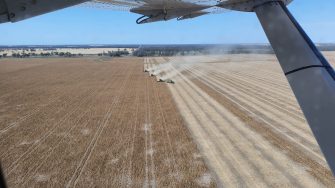
Date: Tuesday, November 10, 2020
Project: Eastern Australian Waterbird Survey
Observers: Richard Kingsford UNSW, John Porter UNSW/DPIE
Pilot: James Barkell NSW National Parks & Wildlife Service (DPIE)
Today we headed north to the most productive parts of the Gwydir wetlands, the Gingham watercourse and the end of the Gwydir. This meant first flying along the Gwydir, past what is known as the raft, a build-up of logs in the river. Past the main channel of the river, there were large parts of the floodplain where the floodplain trees were severely stressed from lack of water.
We then flew west, along the Gwydir River, until we reached the predominantly dry reedbed areas. There were only a few waterbirds, where there was a bit of flooding, perhaps only a few hundred.
Much of the wetland area has been converted to either cotton or wheat around here. Most of the large dams used for storing water for cotton were dry, but harvesting of cereal crops was happening everywhere.
We then went north to survey the Gingham Watercourse country from west to east. At its most westerly end, there was no water with just a few patches of water, predominantly confined to the channel until we got to the main reedbeds.
Wherever there was water, there were waterbirds, including about thirty brolgas and a couple of black-necked storks or jabirus, one a young one. One patch of water also had a white-bellied sea eagle sitting on it.
We then surveyed a few lagoons with water, one had a few thousand grass whistling-ducks or plumed whistling-ducks. The are spectacular when they fly up in large numbers.
We also surveyed a couple of creeks to the north which were surrounded by agricultural areas and had no waterbirds, before we headed back to Moree to refuel.
Once we had refuelled, we headed back along the Mehi River and Mallowa Creek systems which are to the southwest of Moree. These only had one or two black duck and wood duck, not much else. These areas just had remnant floodplain surrounded by agricultural areas and are not particularly good waterbird habitat unless there is flooding onto the floodplains.
This completed the Gwydir wetland surveys, just leaving us a couple of days to do the southern survey bands of the Eastern Australian Waterbird survey next week. I didn’t think we would ever get it all done this year, given border restrictions. And so it will be great to once again finish another survey year.
